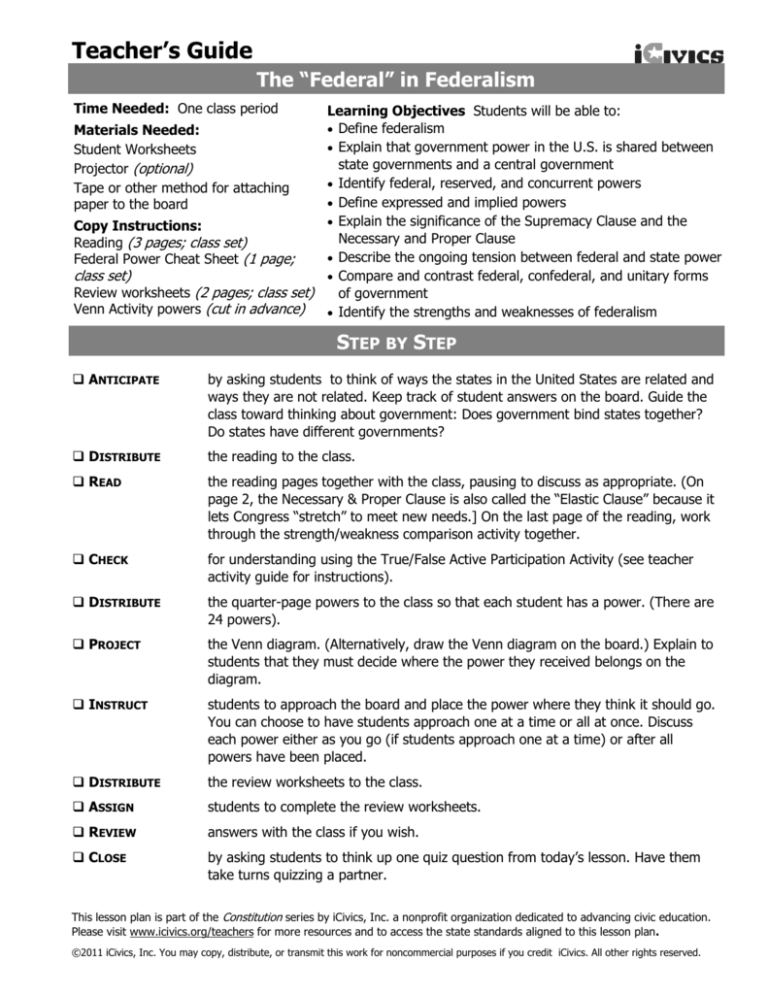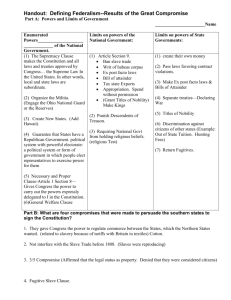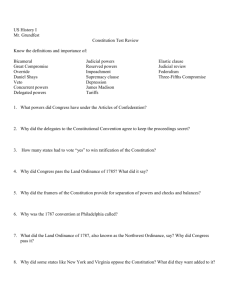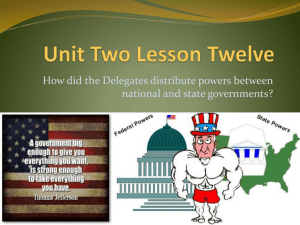
Teacher’s Guide
The “Federal” in Federalism
Time Needed: One class period
Learning Objectives Students will be able to:
Define federalism
Explain that government power in the U.S. is shared between
state governments and a central government
Identify federal, reserved, and concurrent powers
Define expressed and implied powers
Explain the significance of the Supremacy Clause and the
Copy Instructions:
Necessary and Proper Clause
Reading (3 pages; class set)
Describe the ongoing tension between federal and state power
Federal Power Cheat Sheet (1 page;
class set)
Compare and contrast federal, confederal, and unitary forms
Review worksheets (2 pages; class set)
of government
Venn Activity powers (cut in advance)
Identify the strengths and weaknesses of federalism
Materials Needed:
Student Worksheets
Projector (optional)
Tape or other method for attaching
paper to the board
STEP BY STEP
ANTICIPATE
by asking students to think of ways the states in the United States are related and
ways they are not related. Keep track of student answers on the board. Guide the
class toward thinking about government: Does government bind states together?
Do states have different governments?
DISTRIBUTE
the reading to the class.
READ
the reading pages together with the class, pausing to discuss as appropriate. (On
page 2, the Necessary & Proper Clause is also called the “Elastic Clause” because it
lets Congress “stretch” to meet new needs.] On the last page of the reading, work
through the strength/weakness comparison activity together.
CHECK
for understanding using the True/False Active Participation Activity (see teacher
activity guide for instructions).
DISTRIBUTE
the quarter-page powers to the class so that each student has a power. (There are
24 powers).
PROJECT
the Venn diagram. (Alternatively, draw the Venn diagram on the board.) Explain to
students that they must decide where the power they received belongs on the
diagram.
INSTRUCT
students to approach the board and place the power where they think it should go.
You can choose to have students approach one at a time or all at once. Discuss
each power either as you go (if students approach one at a time) or after all
powers have been placed.
DISTRIBUTE
the review worksheets to the class.
ASSIGN
students to complete the review worksheets.
REVIEW
answers with the class if you wish.
CLOSE
by asking students to think up one quiz question from today’s lesson. Have them
take turns quizzing a partner.
This lesson plan is part of the Constitution series by iCivics, Inc. a nonprofit organization dedicated to advancing civic education.
Please visit www.icivics.org/teachers for more resources and to access the state standards aligned to this lesson plan.
©2011 iCivics, Inc. You may copy, distribute, or transmit this work for noncommercial purposes if you credit iCivics. All other rights reserved.
The “Federal” in Federalism
Name:
United States
The United States is one country—but it’s also a bunch of states.
You could almost say it’s a group of states that are... well...
united. When our country was born, thirteen states already
existed. Each one had been a British colony before gaining
independence from Britain after the Revolutionary War. These
new states wanted to come together as one nation, but they
also wanted to be independent. After all, they’d just won their
freedom from a powerful government! They needed a central
government that would share power with the states, and that’s
exactly what they created when they wrote the Constitution.
Who is in charge? States or the federal
government?
Let’s Get Together
Each state already had its own government, so it wasn’t as if the new
Americans were running amok. But if the new United States was going to
be able to deal with other nations, it needed one government that would
speak for the entire country. It also needed one central government to
do things like declare war on other countries, keep a military, and
negotiate treaties with other countries. Each state also had its own court
system, but there needed to be federal courts where citizens from
different states could resolve their disputes.
Government on Two Levels
The United States Constitution creates a central government known as
the federal government. The federal government deals with issues that
affect the entire country. Each state also has its own state government
that only handles the affairs of that state. This division of power between
a central government and state governments is called federalism.
The federal government gets all of its power from the Constitution.
Federal power is divided among three branches of government: the
executive, legislative, and judicial branches. The Constitution explains the
role and powers of each branch. In order to keep the federal government
from becoming too powerful, the Constitution says that any power not
given to the federal government is a power the states or the people keep
for themselves. There a few powers that both the states and the federal
government share.
The Supremacy Clause
Federal laws are
superior to state laws
Before the Constitution, the United States tried another government that
was very weak. It wasn’t able to get much done because states could just
ignore all the laws it passed—and they did! The Constitution has some
very important language to prevent this:
This Constitution, and the laws of the United States which shall be
made in pursuance thereof… shall be the supreme law of the land.
That means federal laws passed by Congress are supreme—they are
superior to state laws. The Founders of our country learned from
experience that this was necessary in order for the federal government to
keep the power the Constitution gives it.
Reading p.1
t of 1964
The “Federal” in Federalism
Name:
Federal Power: Expressed Powers
The Constitution gives most of the federal power to Congress. This was
another way of limiting federal power: Because members of congress
represent citizens in their home states, they are most likely to be
responsive to citizens’ wants and needs. The Constitution gives Congress
two types of powers. The most obvious type is expressed powers. When
you express yourself, you state how you feel. Similarly, expressed
powers are actually stated, or “expressed,” in the Constitution. Each
branch has expressed powers, but you mostly hear this term in reference
to Congress. The Constitution states that Congress has the power to do
things like coin money, declare war, and establish immigration laws.
Implied Powers
Implied powers are not expressly stated in the Constitution. When you
imply something, your intention is clear even though you don’t actually
say it. For example, if you have permission to go to the mall, you
probably also have permission to go into the stores in the mall.
Permission to go into the stores is implied.
Can you guess why the Necessary
and Proper Clause is also called
the Elastic Clause?
In the Constitution, the implied powers of Congress come from the
Necessary and Proper Clause. This is a part of the Constitution that
says Congress may make any law that is “necessary and proper” for
carrying out its expressed powers. So the Constitution doesn’t say
Congress has the power to create a Postal Service website, but it does
say Congress can establish post offices. Permission to create the website
is implied because it is “necessary and proper” to running the post office.
Federal Power in Action
Sometimes Congress exercises powers it does not appear to have. The Civil
Rights Act of 1964 is a good example. Congress wanted to prohibit racial
discrimination in America… but that’s not on the list of powers Congress
has. So how could Congress do this? They did it by finding a link between
racial discrimination and “interstate commerce”—something Congress does
have power over. The Civil Rights Act prohibits racial discrimination by any
facility that has anything to do with interstate commerce, which almost
everything does. Finding these kinds of links is how Congress takes many
actions that, at first, appear to be beyond its power.
During the long period of legal
discrimination known as “Jim
Crow,” people of color often had
trouble finding businesses that
would serve them, especially in
the South.
Today’s Federalism Debate
Just as when the nation was born, many people today are concerned about
a powerful federal government. They worry that their freedom will be
limited if the federal government makes decisions that should be made by
local governments. At the same time, others worry that some issues need
one decision that applies to everyone. They believe it isn’t fair when some
states do more or less to address a problem than other states do. If you
follow the news, you’ll see the federalism debate everywhere: Does the
federal government have the power to pass laws about guns? Health care?
Schools? The variety of opinions on these questions are all part of the twohundred-year-old struggle between federal and state power.
Reading p.2
The “Federal” in Federalism
Name:
If Not Federalism, Then What?
When the Founders wrote the Constitution, they could have chosen any type
of government. What if they had chosen something else? Would it have
lessened the power struggle between the states and the central government?
Maybe, but there are benefits and drawbacks to any type of government. The
following activity compares federalism with two other forms of government.
Read about each type and mark each characteristic S if it’s a strength
and W if it’s a weakness. What role does the central government play?
Federal: Set of Chairs
A federal form of government splits power between independent
states and a central government. The power rests in both places,
and each gets its authority from a governing document, like the
U.S. Constitution. Independent branches inside the central
government may also share power.
____ There is national unity, but local governments can act as well
____ Citizens have more opportunities to be heard
____ Services can be duplicated by different levels of government
____ Disputes occur between national power and states’ rights
The states and central
government must work together
and balance each other out, like
a set of chairs around the table.
Confederal: Many Different Chairs
A confederation of states is
like a bunch of different chairs
grouped together. They hold
power independently but
work collectively.
The confederal form of government is an association of independent
states. The central government gets its authority from the
independent states. Power rests in each individual state, whose
representatives meet to address the needs of the group. America
tried a confederal system before the Constitution. It didn’t work
because the states did not give the central government enough
power to do its job.
____ Keeps the power of government at the local level
____ States cooperate without losing their independence
____ Central government may be too weak to be effective
____ Laws may differ from state to state; no uniformity
Unitary: One Big Chair
In a unitary form of government, all the power rests in a central
government. The country may be divided into states or other sub-units,
but they have no power of their own. For example, England depends on
its Parliament, a legislative body, to create and enforce the laws in the
country. The leader of the nation, the Prime Minister, is a member of the
Parliament and does not have any more power than its members.
____ Uniform laws, policies, and enforcement across the country
____ Little conflict between state and national governments
____ Government may be slow to meet local problems
____ Difficult to meet all the needs of all the citizens
A unitary government is like
one really big chair, with all
of the government’s power
sitting in one place.
Reading p.3
The “Federal” in Federalism
** TEACHER GUIDE **
True/False Active Participation Activity
Directions. Read each statement aloud to the class. Have the class answer by saying “True” or “False”
as a chorus or by showing you thumbs-up for true and thumbs-down for false. Listen or watch for
conflicting answers, indicating confusion. Briefly discuss each answer before moving on.
1. States had no government at all when America was born. (F — each state had
its own government)
2. America’s central government is known as the federal government. (T)
3. Federalism is the division of power between states. (F — between states and a
central government)
4. The Constitution divides federal power among three branches of
government. (T)
5. Powers not given to the federal government are reserved for the states or
the people. (T)
6. Powers that states and the federal government share are called concurrent
powers. (T)
7. The Supremacy clause says state laws are superior to federal laws. (F — it’s
the other way around!)
8. Implied powers are stated in the constitution and expressed powers are
not. (F — it’s the other way around)
9. The Constitution lets Congress do what is “necessary and proper” for
carrying out its powers. (T)
10. Congress can’t pass laws that have anything to do with powers it doesn’t
have, even if there is a link to a power it does have. (F — Congress often
passes laws by finding links to the powers it has)
11. People today still debate about how much power states and the federal
government should have. (T)
12. The Founders had to create a federal government system because there
weren’t any other systems to choose from. (F — there are many types of
government systems)
13. An association of independent states is called a unitary form of government.
(F — confederal)
14. A unitary form of government does not divide power between a central
government and lower governments. (T)
Active Participation Activity
The “Federal” in Federalism
** TEACHER GUIDE **
Venn Diagram Activity
Directions. Before class, print and cut the quarter-page powers. To do the activity, project the large
Venn diagram. Distribute the powers to students (there are 24 powers) along with a way for students to
affix the powers to the diagram. Also give each student a Federal Powers Cheat Sheet. Have students
attach their powers to the Venn diagram where they think the powers belong. Review and discuss.
Here are the answers:
Expressed and Implied Powers
Print money
Make rules about trade between states and nations
Declare war
Make treaties and deal with foreign countries
Establish a post office
Provide an army and a navy
Make laws that are necessary and proper to carry out its powers
Spend money for the general welfare
Make copyright laws to protect authors’ writings
Decide what units of measure we will use
Reserved Powers
Issue driver’s and marriage licenses
Conduct elections
Establish local governments
Make rules about business inside a state
Use any power the Constitution doesn’t give the federal government or
deny to the states
Charter banks and corporations
Run public schools
Provide police and emergency services
Concurrent Powers
Protect public health and safety
Collect taxes
Build roads
Borrow money
Establish courts
Make and enforce laws
Venn Diagram Activity
The “Federal” in Federalism
Name:
Federal Power Cheat Sheet
The “Federal” in Federalism
Venn Diagram
The “Federal” in Federalism
Name:
A. Crossword. Use what you learned in the reading to complete the crossword puzzle.
ACROSS
5. Type of government where the central
government has all the power
6. Type of government where states and a central
government share power
10. Special name for powers that both the states
and federal government share
12. Powers that are actually stated in the
Constitution
13. The federal government gets all of its power
from this
1
2
3
4
5
6
7
8
9
10
DOWN
1. Type of government where the central
government gets its power from the states
12
2. When America was born, each state already
had one of these
3. Clause that says federal laws are superior
13
to state laws
4. The necessary and proper clause is also known as the _______ clause.
7. Division of power between a central government and state governments
8. A word that describes the relationship of the states in America
9. The country that ruled the American colonies before the Revolutionary War
11. Powers that are not actually stated in the Constitution
11
B. Strengths and Weaknesses. Read each description of federalism. Does it describe a strength or a
weakness of federalism? Label each line with an S for strength or W for weakness.
_____
_____
_____
_____
_____
_____
_____
_____
Review p.1
The “Federal” in Federalism
Name:
C. Federal Powers. Match each headline to the expressed power found in the Constitution.
A.
B.
C.
D.
President Orders
Executive Branch to
Carry Out New Law!
Congress Says Print
More $2 Bills!
Supreme Court to
Decide If New Ban is
Constitutional
Congress Restricts
Handguns in District
of Columbia
E.
F.
G.
H.
President: “Troops
Will Come Home”
Budget Falls Short;
U.S. to Borrow
$10 Billion
Congress Extends
Income Tax Cuts to
Middle Class
Agreement Reached
on New Immigration
Bill!
____ 1. “The President shall be Commander in Chief of the Army and Navy of the United States…”
____ 2. “The Congress shall have the Power… to establish an uniform rule of Naturalization…”
____ 3. “The judicial Power shall extend to all Cases … arising under this Constitution, the Laws of the
United States, and Treaties made … under their Authority…”
____ 4. “The Congress shall have the power to...coin Money…”
____ 5. “...he shall take Care that the Laws be faithfully executed...”
____ 6. “The Congress shall have the power to lay and collect taxes on incomes…”
____ 7. “The Congress shall have the Power...to exercise exclusive Legislation in all Cases whatsoever,
over such District... as may... become the Seat of the Government of the United States…”
____ 8. “The Congress shall have the Power… To borrow Money on the credit of the United States…”
D. Different Governments. Imagine you are in charge of creating a government for a brand new
country! Which system would you choose if...
____ 1. You want the central government to have the most power?
____ 2. You want laws to be the same throughout the country?
____ 3. You want the central government to have the least power?
____ 4. You want individual states to keep as much independence as
possible?
____ 5. You want both national laws and state laws to exist?
____ 6. You don’t care whether individual states have any power?
____ 7. You want a balance between power in the states and the
central government?
____ 8. You want there to be few, if any, national laws?
Review p.2
The “Federal” in Federalism
** TEACHER GUIDE **
Name:
A. Crossword. Use what you learned in the reading to complete the crossword puzzle.
ACROSS
5. Type of government where the central
government has all the power
6. Type of government where states and a central
government share power
10. Special name for powers that both the states
and federal government share
12. Powers that are actually stated in the
Constitution
13. The federal government gets all of its power
from this
DOWN
1C
2G
O
O
N
V
6F
E
D
E
3S
R
A
4E
5U
L
P
N
I
T
A
R
Y
E
R
A
R
7F
8U
D
N
S
E
E
N
9B
E
M
T
M
D
I
R
R
E
I
A
E
T
I
A
N
L
T
10
C
O
1. Type of government where the central
government gets its power from the states
12
2. When America was born, each state already
E
X
had one of these
3. Clause that says federal laws are superior
13
C O N S
T
I
T
U T
to state laws
4. The necessary and proper clause is also known as the _______ clause.
7. Division of power between a central government and state governments
8. A word that describes the relationship of the states in America
9. The country that ruled the American colonies before the Revolutionary War
11. Powers that are not actually stated in the Constitution
N
C
U
Y
R
R
A
E
N
D
T
A
11
I
L
I
M
I
N
P
R
E
L
I
S
S
E
D
M
O
N
E
D
B. Strengths and Weaknesses. Read each description of federalism. Does it describe a strength or a
weakness of federalism? Label each line with an S for strength or W for weakness.
__W__
__W__
__S__
__S__
__W__
__S__
__S__
__W__
Review p.1
The “Federal” in Federalism
Name:
** TEACHER GUIDE **
C. Federal Powers. Match each headline to the expressed power found in the Constitution.
A.
B.
C.
D.
President Orders
Executive Branch to
Carry Out New Law!
Congress Says Print
More $2 Bills!
Supreme Court to
Decide If New Ban is
Constitutional
Congress Restricts
Handguns in District
of Columbia
E.
F.
G.
H.
President: “Troops
Will Come Home”
Budget Falls Short;
U.S. to Borrow
$10 Billion
Congress Extends
Income Tax Cuts to
Middle Class
Agreement Reached
on New Immigration
Bill!
_E__ 1. “The President shall be Commander in Chief of the Army and Navy of the United States…”
_H__ 2. “The Congress shall have the Power… to establish an uniform rule of Naturalization…”
_C__ 3. “The judicial Power shall extend to all Cases … arising under this Constitution, the Laws of the
United States, and Treaties made … under their Authority…”
_B__ 4. “The Congress shall have the power to...coin Money…”
_A__ 5. “...he shall take Care that the Laws be faithfully executed...”
_G__ 6. “The Congress shall have the power to lay and collect taxes on incomes…” [Amendment 16]
_D__ 7. “The Congress shall have the Power...to exercise exclusive Legislation in all Cases whatsoever,
over such District... as may... become the Seat of the Government of the United States…”
_F__ 8. “The Congress shall have the Power… To borrow Money on the credit of the United States…”
D. Different Governments. Imagine you are in charge of creating a government for a brand new
country! Which system would you choose if...
_C__ 1. You want the central government to have the most power?
_C__ 2. You want laws to be the same throughout the country?
_B__ 3. You want the central government to have the least power?
_B__ 4. You want individual states to keep as much independence as
possible?
_A__ 5. You want both national laws and state laws to exist?
_C__ 6. You don’t care whether individual states have any power?
_A__ 7. You want a balance between power in the states and the
central government?
_B__ 8. You want there to be few, if any, national laws?
Review p.2










